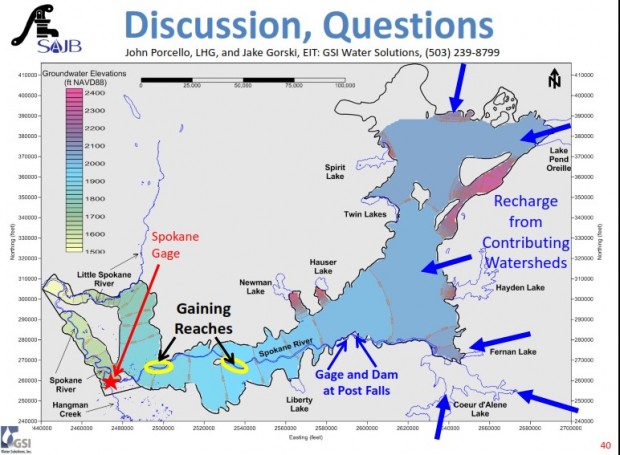Spokane River Low Flows Watershed Hydrology
On March 3rd, 2016, John Porcello and Jake Gorksy of GSI Water Solutions presented a summary of research contracted by the SAJB to evaluate historical and recent changes in the seasonal low flows of the Spokane River, as measured at two USGS stream flow gaging stations with long-term records: the Spokane Gage at Spokane (in downtown Spokane) and the Post Falls Gage (located just downstream of Post Falls Dam). The role of groundwater in the Spokane Valley – Rathdrum Prairie (SRVP) Aquifer also will be discussed, particularly with regards to trends in groundwater levels and the degree to which goundwater inflows to the river in two gaining reaches are affected by summerseason increases in groundwater pumping to meet urban and agricultural water demands.
SAJB – GSI Presentation No. 1 March 2016 – Notes Pages
SAJB – GSI Presentation No. 2 March 2016 – NotesPages
Conclusions SAJB 2014-2016 Studies
1. Urbanization has reduced water use below historical levels. Lower volumes of use during irrigation season from nearly 450 cfs to about 275 cfs in Washington alone. Idaho expects a 47 cfs reduction by 2045 due to urbanization. Indoor uses return most water to river/aquifer system. Passive and active water conservation measures have reduced WA per-capita use by 30% since the 1980s peak.
2. Groundwater elevations are at or above historical levels and have not shown declines during the recent decades of expanded urbanization in WA and ID.
3. SVRP use is increasing in Idaho, but not Washington.
4. The Idaho increase has minimal effect on the river. Indoor uses return most water to river/aquifer system, Pumping for outdoor uses in Idaho is seasonal and occurs too far away from the river’s gaining reaches to have a discernable effect during the river’s low-flow season.
5. The continued decline in seasonal low flows in the Spokane River is occurring despite two positives: a.) Declining usage in Washington (volumetric and per-capita) and b.) Reduced water demands in both states arising from the agricultural-to-urban conversion of land and water use.
6. Changing hydrology in the contributing watershed to Coeur d’Alene Lake is the dominant cause of continued declines in Spokane River seasonal low flows. Annual precipitation is not showing declines, but other critical conditions are affecting the watershed’s magnitudes and timing of inflows to the lake. Lower snowpack volumes and higher temperatures. Implications: earlier snowmelt, smaller runoff volumes in late winter and spring and lower summer stream inflows

